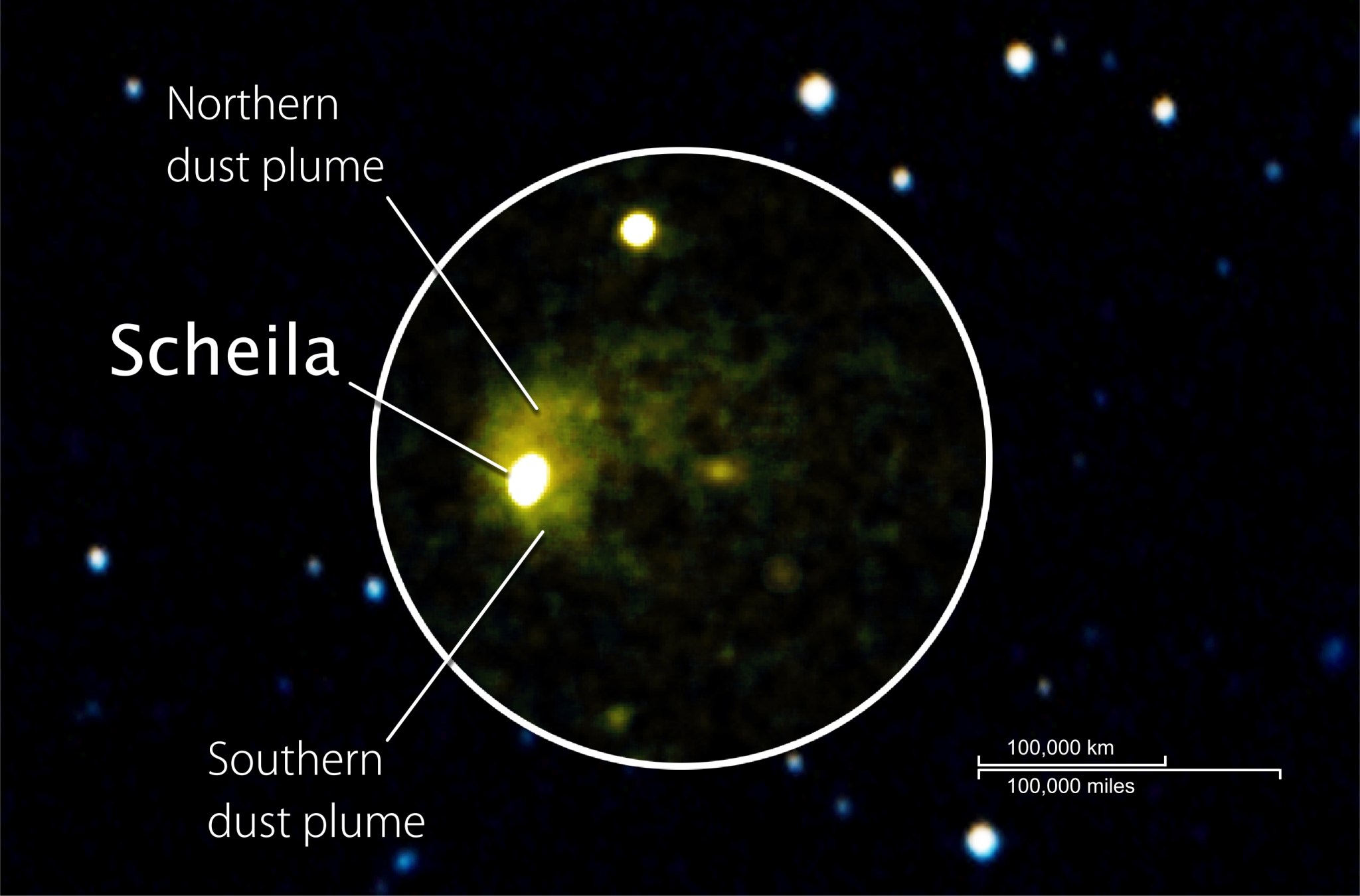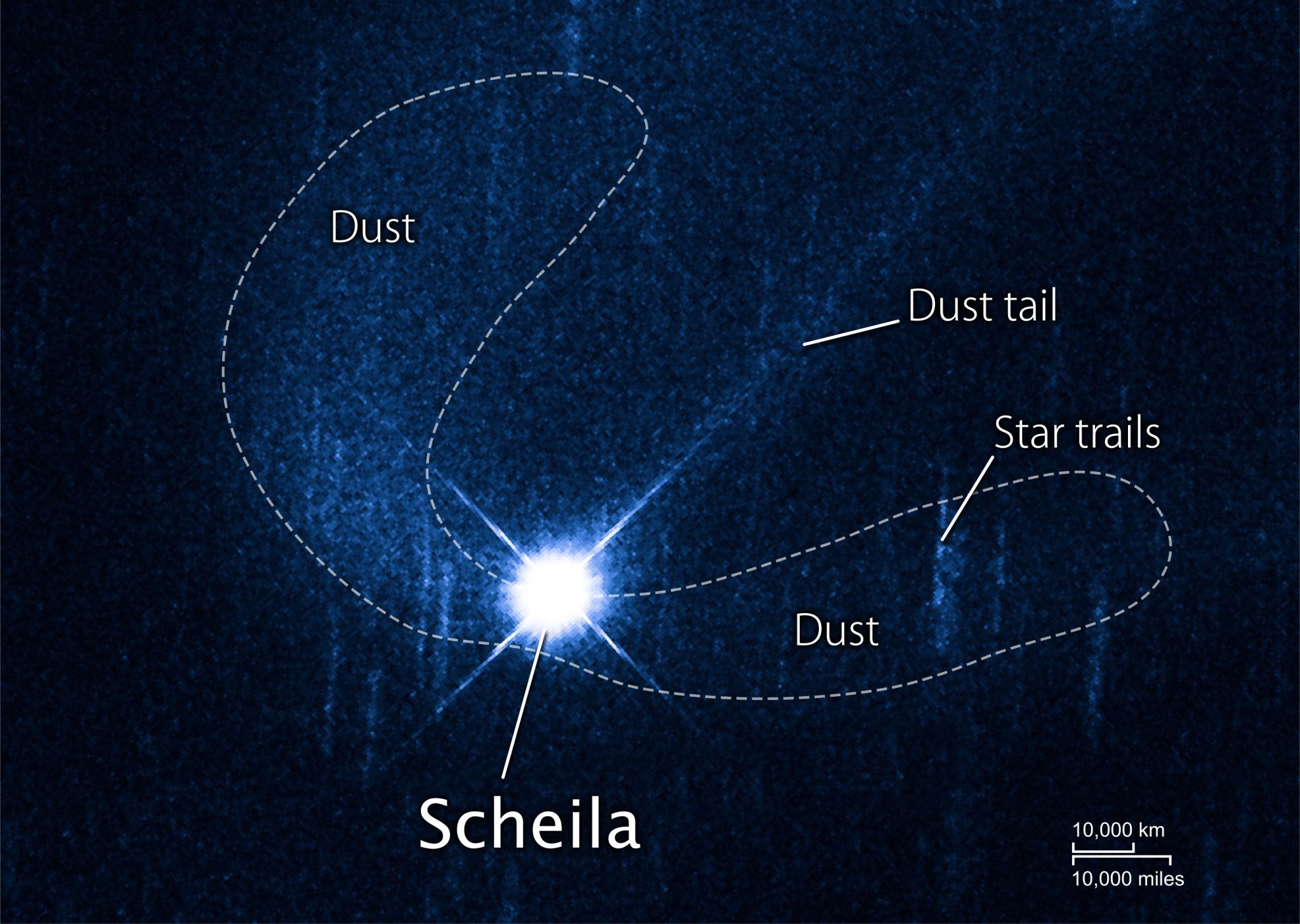Late last year, astronomers noticed an asteroid named Scheila had unexpectedly brightened, and it was sporting short-lived plumes. Data from NASA’s Swift satellite and Hubble Space Telescope showed these changes likely occurred after Scheila was struck by a much smaller asteroid.
“Collisions between asteroids create rock fragments, from fine dust to huge boulders, that impact planets and their moons,” said Dennis Bodewits, an astronomer at the University of Maryland in College Park and lead author of the Swift study. “Yet this is the first time we’ve been able to catch one just weeks after the smash-up, long before the evidence fades away.”
Asteroids are rocky fragments thought to be debris from the formation and evolution of the solar system approximately 4.6 billion years ago. Millions of them orbit the sun between Mars and Jupiter in the main asteroid belt. Scheila is approximately 70 miles across and orbits the sun every five years.
“The Hubble data are most simply explained by the impact, at 11,000 mph, of a previously unknown asteroid about 100 feet in diameter,” said Hubble team leader David Jewitt at the University of California in Los Angeles. Hubble did not see any discrete collision fragments, unlike its 2009 observations of P/2010 A2, the first identified asteroid collision.
The studies will appear in the May 20 edition of The Astrophysical Journal Letters and are available online.

Astronomers have known for decades that comets contain icy material that erupts when warmed by the sun. They regarded asteroids as inactive rocks whose destinies, surfaces, shapes and sizes were determined by mutual impacts. However, this simple picture has grown more complex over the past few years.
During certain parts of their orbits, some objects, once categorized as asteroids, clearly develop comet-like features that can last for many months. Others display much shorter outbursts. Icy materials may be occasionally exposed, either by internal geological processes or by an external one, such as an impact.
On Dec. 11, 2010, images from the University of Arizona’s Catalina Sky Survey, a project of NASA’s Near Earth Object Observations Program, revealed Scheila to be twice as bright as expected and immersed in a faint comet-like glow. Looking through the survey’s archived images, astronomers inferred the outburst began between Nov. 11 and Dec. 3.

Three days after the outburst was announced, Swift’s Ultraviolet/Optical Telescope (UVOT) captured multiple images and a spectrum of the asteroid. Ultraviolet sunlight breaks up the gas molecules surrounding comets; water, for example, is transformed into hydroxyl and hydrogen. But none of the emissions most commonly identified in comets, such as hydroxyl or cyanogen, show up in the UVOT spectrum. The absence of gas around Scheila led the Swift team to reject scenarios where exposed ice accounted for the activity.
Images show the asteroid was flanked in the north by a bright dust plume and in the south by a fainter one. The dual plumes formed as small dust particles excavated by the impact were pushed away from the asteroid by sunlight. Hubble observed the asteroid’s fading dust cloud on Dec. 27, 2010, and Jan. 4, 2011.
The two teams found the observations were best explained by a collision with a small asteroid impacting Scheila’s surface at an angle of less than 30 degrees, leaving a crater 1,000 feet across. Laboratory experiments show a more direct strike probably wouldn’t have produced two distinct dust plumes. The researchers estimated the crash ejected more than 660,000 tons of dust – equivalent to nearly twice the mass of the Empire State Building.
“The dust cloud around Scheila could be 10,000 times as massive as the one ejected from comet 9P/Tempel 1 during NASA’s UMD-led Deep Impact mission,” said co-author Michael Kelley, also at the University of Maryland. “Collisions allow us to peek inside comets and asteroids. Ejecta kicked up by Deep Impact contained lots of ice, and the absence of ice in Scheila’s interior shows that it’s entirely unlike comets.”
NASA’s Goddard Space Flight Center in Greenbelt, Md., manages Hubble and Swift. Hubble was built and is operated in partnership with the European Space Agency. Science operations for both missions include contributions from many national and international partners.
By Francis Reddy
NASA’s Goddard Space Flight Center, Greenbelt, Md.
























